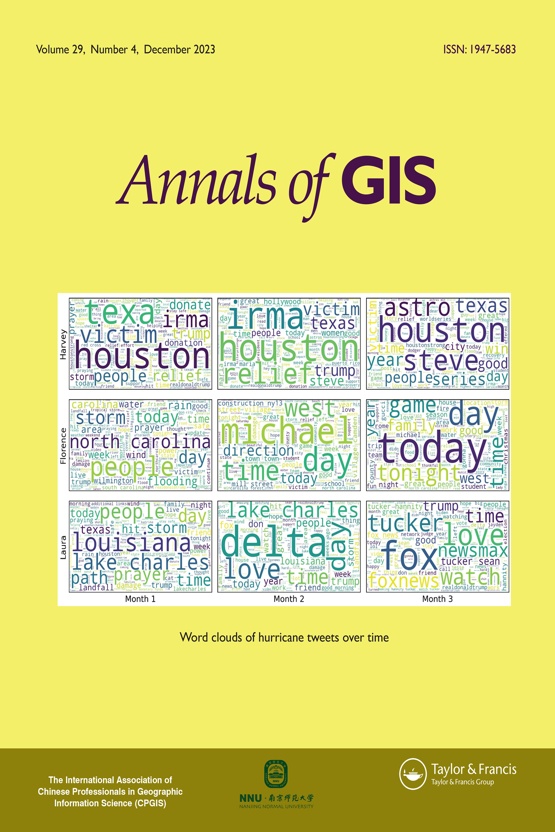Submit a Manuscript to the Journal
Annals of GIS
For an Article Collection on
Cryosphere and Climate Change Monitoring Using Geospatial Technology
Manuscript deadline
30 June 2024

Article collection guest advisor(s)
Dr. Ajay Kumar Taloor ,
University of Jammu, Jammu, India
[email protected]
Dr. Sushil Kumar Singh,
Space Applications Centre, India Space Research Organization, Ahmedabad, India
[email protected]
Dr. Barasa Bernard,
Department of Geography, Kyambogo University, Kampala, Uganda
[email protected]
Dr. Kapil Malik ,
Radar System and Services, Noida, India
[email protected]
Cryosphere and Climate Change Monitoring Using Geospatial Technology
The Earth’s cryosphere is an integral part of the global climate system. Its components, including glaciers, ice sheets, sea ice, snow cover, and permafrost, play critical roles in regulating climate and supporting ecosystems. However, these components are vulnerable to the effects of a warming climate and are undergoing profound changes due to the impacts of climate change. Melting glaciers, retreating ice sheets, and shifting permafrost are not only emblematic of global warming but also have far-reaching implications for our planet. Water availability and stream flow are significantly influenced by the climate and glacier extent around the mountainous region in all parts of the Earth. The changing climate is causing significant shifts in the cryosphere and runoff patterns in all the major rivers around the world. Therefore, understanding the dynamics of the cryosphere is essential for assessing the broader impacts of climate change.
Geospatial technique, including Geographic Information System (GIS) and Remote Sensing (RS), plays a critical role in understanding, mitigating, and adapting to the impacts of climate change, particularly in large and inaccessible regions with arid harsh weather and complex topography. Scientists now have access to a variety of space based in unprecedented quantities and resolutions, while new approaches such as machine learning have greatly advanced the potential for data mining, image classification, and information extraction.
For this Article Collection, we invite submissions of studies applying all types of science using geospatial technology to address the status, methods, and changes of the global water cryosphere and climate change. Our topics are, but not limited to the following:
- Geospatial technology applications for glacial lakes, ice sheets, ice shelves and sea ice,
- Applications SAR for climate change
- Geospatial tools for cryosphere changes
- Limitations of remote sensing data collection, retrieval, and uncertainties
- POLSAR for glacier facies and mass balance studies
- Space based inputs for glacier studies and water resources applications
- Optical and Thermal Remote sensing data for glacier dynamics and climate change
- Automated detection of rock using deep learning and object-based image analysis
- GLOFs modelling and climate science
- GRACE/ GRACE-FO SAR for glacier dynamics and climate change
Guest Advisors Biography:
Dr. Ajay Kumar Taloor has obtained his PhD in Remote Sensing and GIS applications in hydrogeology from University of Jammu, Jammu, India. Dr. Ajay Kumar Taloor has 15 years of research experience in the applications in Geospatial Technology for land and water resources. Being an expert of Remote Sensing applications in Water Science, Cryosphere and Climate Change, He has published more than 100 research articles in the international journals and edited many volumes in the top-rated journals in the Elsevier and Springer publishers.
Dr. Sushil Kumar Singh is presently working as a scientist at Space Applications Centre ISRO, Ahmedabad. He has been a key member for national and global level cryosphere applications program using space and ground based observations. He has more than 20 years of experience of remote sensing applications for cryosphere and has participated in Indian Scientific Expeditions to Antarctica (summer team) and many other glacier expeditions, snow field campaigns.
Dr. Barasa Bernard is a lecturer in the Department of Geography Kyambogo University. He has a PhD in environmental geography, M.Sc. in environment and natural resources, postgraduate Diploma in project planning and management, and bachelor’s degree in environmental management. He specializes in the use of Geographical Information Systems and Remote Sensing technologies in disaster risk management, climate change adaptation, water and wetland resources management and other related fields.
Dr. Kapil Malik received the PhD degree from the Indian Institute of Technology (IIT)-Indian School of Mines Dhanbad in 2022. He holds the Master of Science (M.Sc.) degree in remote sensing and GIS application. He has vast experience in the application of remote synthetic aperture radar (SAR)/microwave remote sensing. He has worked extensively on digital elevation models (DEM), persistent scatterer SAR interferometry (PSInSAR), SAR polarimetry toward environmental monitoring and solving sustainability issues. He has published several papers covering the study of landslide, earthquake, building subsidence, dam subsidence and crustal deformation.
Benefits of publishing open access within Taylor & Francis
Global marketing and publicity, ensuring your research reaches the people you want it to.
Article Collections bring together the latest research on hot topics from influential researchers across the globe.
Rigorous peer review for every open access article.
Rapid online publication allowing you to share your work quickly.
Looking to Publish your Research?
Find out how to publish your research open access with Taylor & Francis Group.
Choose open accessSubmission Instructions
All manuscripts submitted to this Article Collection will undergo desk assessment and peer-review as part of our standard editorial process. Guest Advisors for this collection will not be involved in peer-reviewing manuscripts unless they are an existing member of the Editorial Board. Please review the journal Aims and Scope and author submission instructions prior to submitting a manuscript.